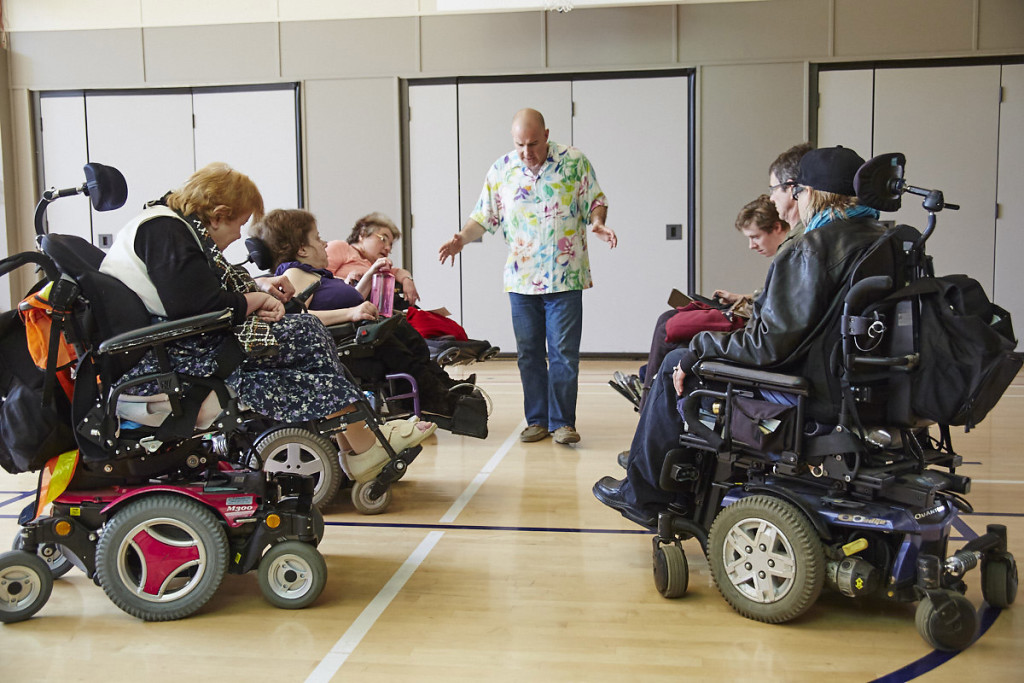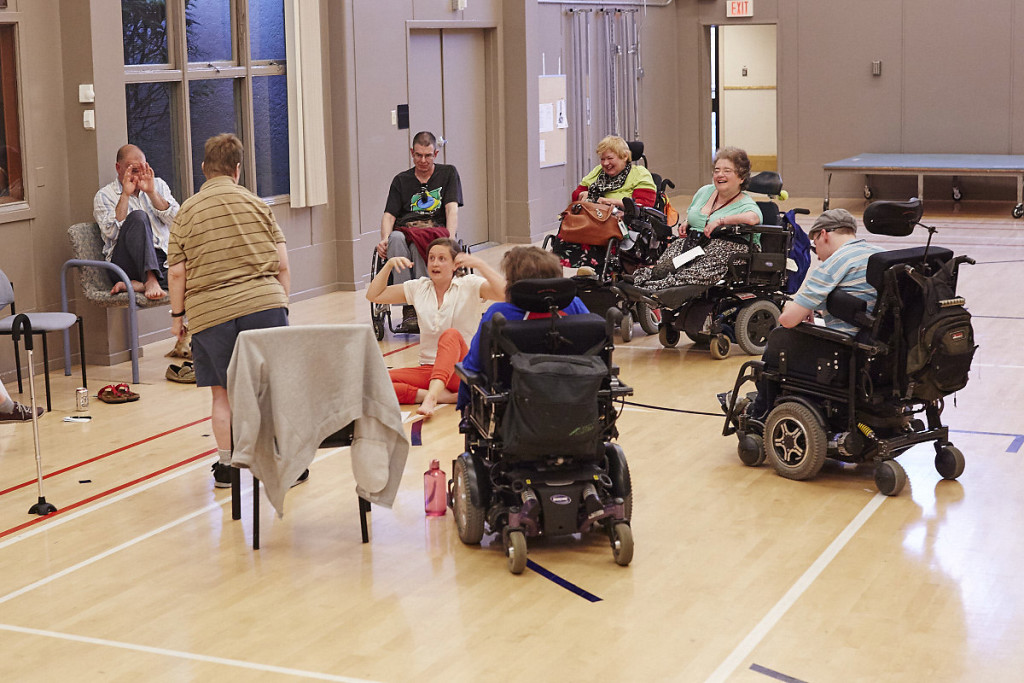Realwheels Theatre has heart like no other theatre company in Vancouver. Their mission is to promote the respectful and accurate representation of disability in the public eye. The company has been responsible for producing shows that allow the talents of the disabled community to shine. They are also responsible for raking in a whole army of theatres awards. If that doesn’t sound enticing enough, consider their latest offering, Super Voices, a show performed and created by an entire cast from the disabled community. Super Voices tells stories about the superhuman powers that people with disabilities possess- powers of patience, compassion, and alternate modes of communication. The show is also a multimedia performance. It is accompanied by elaborate projection pieces designed, by the very best in the business, Jamie Nesbitt himself. We spoke to Jamie to find out more about this brave and unusual theatre piece.
Tell us about Super Voices. What is the premise of the show?
Super Voices explores one’s identity. The performers often feel that in real life they are defined by their disabilities, when in fact they are obviously much more than that. Their disabilities are definitely a part of who they are but not everything. The performers are asking questions about who they are and who they are beyond their disabilities. That was quite an interesting process to be involved in.
Were the performers involved in the writing process?
Very much so. They worked with professional artists in the community to tell their stories and to find different ways of telling their stories.
How did you get involved with Realwheels Theatre?
I have worked with Realwheels Theatre for a number of years now. I worked on a project called Spine, which was a co-production between the University of Alberta and Realwheels. It was created in Edmonton and Vancouver. I have a long relationship with Realwheels that started almost six years ago.
What has your involvement been as the Projections Designer for the show?
My input is different for every show because my relationship with the director of each show is different. Generally what happens is that a director asks me to be involved in a project between six months to a year prior to any of the production actually happens. We go through an extensive collaborative process of developing the visual world for the show. We think about it and dream about it. We eventually start creating that dream. What a Projections Designer specifically does is projects videos, animations and/or edited content on to a set, and this content interacts with the stage in interesting ways.
Have the projections been particularly different for Super Voices?
My work in Super Voices is quite different. Other shows I’ve done had written scripts and professional actors. It’s great and I love it but that is the more familiar process. Super Voices is different because these performers are not professional actors. This script has never been done before. It is more personal than most of the shows I have worked on.
How did you become a Projections Designer?
I was an actor for a long time. I have been doing theatre since I was twelve. Creating theatre is my life’s passion. I was at Langara College’s Studio 58. I wasn’t enjoying acting anymore. I was really struggling. I was having lots of anxiety on stage. I was questioning why I was even doing it. I was starting to get into film then as well and had made a couple of movies on my own. I thought about combining my love for theatre and film. I saw a show by the Electric Company that had projections and it looked very exciting to me. I ended up working with Robert Gardner as his assistant designer on Studies in Motion. I really just learned everything on the job. The studio was really supportive. I did some design classes. I learned the projections aspect on the job. I was doing shows that I had no business doing because there weren’t many people doing it and I just had really good timing. I have been doing it for ten years now.
You recently got nominated for a Jessie Richardson Theatre Award for your projections in Farewell My Lovely. Can you tell us more about that?
Farewell My Lovely was a co-production between Vertigo Theatre in Calgary and the Arts Club in Vancouver. It was written by a Vancouver playwright called Aaron Bushkowsky. I had worked with him and director Craig Hall many times before. We created this world with Scott Reid who is a great lighting designer. The three of us created a film noir on stage. It was exciting.
You mentored Caspar Ryan for videography in Super Voices. How rewarding was that experience?
Caspar is an incredible artist. He is very, very kind and a very gentle spirit, but he has a very strong backbone at the same time. He is not a pushover and he has all these amazing ideas all the time. We are co-creating Super Voices together. Caspar has gone through a lot in his life but he never complains. He is a really good person and a really interesting artist. It has been a lot of fun working with him. This has been called a mentorship but it doesn’t feel like it because Caspar is really on top of things.
What are the most important lessons you have learned from working with actors with disabilities? How has it changed the way you live your life?
When we go to see a show we assume that the actors will speak in a certain way, that they will be able-bodied. In this show you will see that disabled people speak differently from you. They may be in a wheelchair or have physical ailments, but they are good storytellers too. They have interesting things to say and we just have to listen a bit differently and more openly. We need to shed our expectations about who they are. Coming in to rehearsals there are huge struggles for them, like with physically speaking language. To watch the effort and determination they put into saying lines is very inspiring. My wife’s sister is disabled. Before I met my wife I hardly knew anyone in the disabled community. I was really sheltered. It has been really rewarding to be part of that community in a small way.
Will social issues experienced by the disabled community be addressed in the show?
I wouldn’t consider Super Voices a message driven piece. However, for these actors to do theatre is an inherent commentary on the issues associated with disability in our societies. You can’t really take that out of the piece, which is a great thing.

What future projects do Realwheels have lined up?
I don’t have anything currently in the mix but you never know. It has happened a couple of times now so you never know!
What about your personal goals as a Projections Designer?
I am the co-artistic director of a company called Jump Current Productions. We are currently creating a show that I am writing. My family inherited a castle in Poland and it is based around that. My great uncle was the minister of war in Poland and my great aunt was a movie star, and they had a castle called Salamandra in a city called Zakopane. That is our next project. I am going to Poland on June 22nd to film the castle and meet people connected to the project. It will be a hybrid of film and theatre. It will be like a live documentary on stage.
It sounds very glamorous and mysterious!
It is! But what lies underneath it is also very ugly- the underbelly of fame, power and privilege.
Super Voices plays at the Roundhouse Performance Centre on June 12 at 7.00 pm and June 13 at 4.00 pm. Tickets are pay what you can here.
-Prachi Kamble

